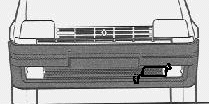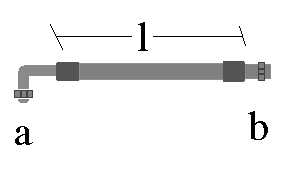
![]()

![]()
Not only water gets hot, oil does too. Specially due to the high turbo bearing temperature, its temperature will rise, so all GTTs come with an oil-water cooler. As water tends to be cooler than oil (around 30°C less), oil is forced, after being filtered, to enter the upper left side of the radiator, and then it goes down through a double cylinder which is dived into the radiator water to leave some of its heat there. The advantage is that the oil temperature is regulated with the water one.
But in a car prone to overheating, this solution reduces the water cooling power as much as oil cooling is not properly achieved. A nice solution is to let the radiator just cool the water and add a second oil radiator to cool the oil.
| First of all, get an oil radiator. I used a Opel Kadett GSi one (I think it's also known as Vauxhall Astra) from a junkyard. | |
| Finding a place for the radiator is actually another pain in the neck, as GTTs don't have much free space there in the hood. But close to the left antifog lamp there are some free openings in the front bumper, after which you can install it, if you are patient enough and make your own supporting pieces. |  |
 |
Then it comes the piping. You can use new oil pipes from the oil filter to your radiator, but it's possible to get some short pipes to lengthen the old ones and keep them, as I did. But obtaining that pipes will be a problem unless you contact someone ready to specially made them for you, as I found E.G.S.in Madrid. That's because the inner diameter and nut size you'll need to connect to the old oil hoses is not very common. Remember to ask for piping that can cope with hot (Over 170 °C) pressure (Over 10 kg/cm2) oil. |
The flexible pipes I needed are detailed in the figure. They have a 'b' type straight 10x100 fixed female ending (10mm depth will be enough) for the 10x100 conic free male at the old pipe end, and a 'a' type 90° elbow with a 18x150 free nut for my new oil radiator. Two of them are needed:
 |
You can use a pair of 10x100 short bolts to close the old water-oil cooler
holes and keep them free of dust. One never knows!
Intercooler and front bumper removal is necessary, while bonnet and front grille removing is highly recommended. In my case, the water radiator screen had to be cut a little to allow the oil radiator to fit and oil hose #2 to get out of it (try to see the night photo :-) ). |
You must be very clean through the work, because when you start the engine, everything in the new oil radiator system will pass to the engine and turbo without being filtered, so previous inside flushing of a junkyard radiator with oil is suggested, as small particles may easily damage the turbo.
Let the starting motor work without allowing the engine to start for a while (for example by taking the ignition module power supply wires off), then start the engine and keep it idle until the oil pressure lamp switches off, because you need to fill the new radiator. After letting the engine reach its working temperature, a change of oil and filter wouldn't do any harm.
Remember the longer way you make oil take, the more time your engine will be working without oil pressure when you start it. I noted a little more time with the oil pressure lamp switched on in the instrument panel after starting, so be careful and keep the engine at low revs while it happens.
Another possibility is to install the oil radiator on the right side, in front of the water radiator over the front chassis bar. Pro: closer to the oil filter. Con: using the same airflow as the water radiator...
Using a oil radiator, your engine will cool more and faster. If you don't install an oil temp gauge, you can guess its temperature using its pressure while idle, lower when it's hot. You shouldn't make the engine work hard until _both_ oil and water are hot enough...
Finally, an oil thermostatic bypass would be interesting not to let the oil cool too much on cold weather.